

Síndrome de realimentación en el paciente críticamente enfermo: Del metabolis... Nutricion y C19. Doc-0g-as-docs.googleusercontent. ASPECTOS PSQUIATRICOS DEL SUICIDIO Criminología Aplicada. v31n4a8. Guia del paciente suicida INPRNF. Tablas del taller. ER.
Art03. 197. CURCUMA LONGA Y SU PONTENCIAL MOLECULAR BENEFICIOSO SOBRE LOS PROCESOS INFLAM... Jurenka J.
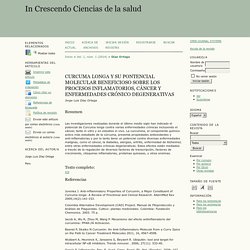
Anti-inflammatory Properties of Curcumin, a Major Constituent of Curcuma longa: A Review of Preclinical and Clinical Research. AlternMed Rev 2009;14(2):141-153. Colombia Alternative Development (CAD) Project. Manual de Fitoprotección y Análisis de Plaguicidas. Cultivo: plantas medicinales. Jacob A, Wu R, Zhou M, Wang P.
Basnet P, Skalko N Curcumin: An Anti-Inflammatory Molecule from a Curry Spice on the Path to Cancer Treatment Molecules 2011, 16, 4567-4598. Wullaert A, Heyninck K, Janssens S, Beyaert R. García P. Blanco L, Martin J, Gómez A y Egido J. Anand P, Sundaram C, Jhurani S, Kunnumakkara AB, Aggarwal BB. Medicina alternativa y complementaria en la enfermedad inflamatoria intestinal. Revisión Complementary and alternative medicine in the inflammatory bowel disease N.
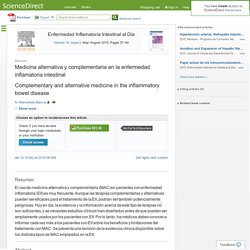
Manceñido Marcos, Sección Aparato Digestivo, Hospital Infanta Sofía, San Sebastián de los Reyes, Madrid, España Received 27 May 2015, Accepted 4 June 2015, Available online 19 August 2015 Choose an option to locate/access this article: Check if you have access through your login credentials or your institution Check access doi:10.1016/j.eii.2015.06.006 Get rights and content. 2013_1-art 6(1) Revision2. Nutr. Hosp. vol.24 número3; Resumen: S0212-16112009000300003. Resumen BENGMARK, S.; MESA, M.ª D. y GIL, A..
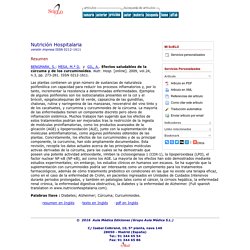
Efectos saludables de la cúrcuma y de los curcuminoides. 53d110f20cf2fd75bc5d667a. Nutrición Hospitalaria - Aplicaciones clínicas del empleo de probióticos en pediatría. Aplicaciones clínicas del empleo de probióticos en pediatría Clinical applications of the use of probiotics in pediatrics.
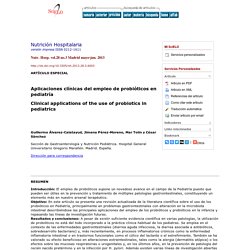
DIPLOMADO NUTRICION CLINICA.
Guía Clínica para la atención de problemas (violencia) Center for Visual Science : University of Rochester. The New York Institute for Special Education Blindness Resource Center. Ophthalmology. American Academy of Ophthalmology. WEB-BASED SYSTEM FOR TRAINING OF MEDICAL DOCTORS AND STUDENTS IN NUTRITION. JECM_(2011)_Pharmacotherapy for Obesity.pdf. NOM. Sarcopenia. OBESIDAD-SARCOPENICA. Medicina del deporte. Enteral Nutrition. Transplante. Endocrinología. Toxicology. AMAEE. ESPGHAN. HNRG. JACC. Lesch–Nyhan syndrome. Lesch–Nyhan syndrome (LNS), also known as Nyhan's syndrome, Kelley-Seegmiller syndrome and juvenile gout,[1] is a rare inherited disorder caused by a deficiency of the enzyme hypoxanthine-guanine phosphoribosyltransferase (HGPRT), produced by mutations in the HPRT gene located on the X chromosome.

LNS affects about one in 380,000 live births.[2] The disorder was first recognized and clinically characterized by medical student Michael Lesch and his mentor, pediatrician William Nyhan, who published their findings in 1964.[3] The HGPRT deficiency causes a build-up of uric acid in all body fluids. This results in both hyperuricemia and hyperuricosuria, associated with severe gout and kidney problems. Neurological signs include poor muscle control and moderate intellectual disability. These complications usually appear in the first year of life.
Signs and symptoms[edit] Overproduction of uric acid[edit] Nervous system impairment[edit] Self-injuring behavior[edit] LNS in females[edit] Lesch-Nyhan Hospital infantil. Phagocyte. During an infection, chemical signals attract phagocytes to places where the pathogen has invaded the body.
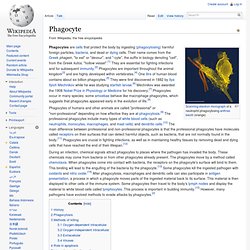
These chemicals may come from bacteria or from other phagocytes already present. The phagocytes move by a method called chemotaxis. When phagocytes come into contact with bacteria, the receptors on the phagocyte's surface will bind to them. This binding will lead to the engulfing of the bacteria by the phagocyte.[13] Some phagocytes kill the ingested pathogen with oxidants and nitric oxide.[14] After phagocytosis, macrophages and dendritic cells can also participate in antigen presentation, a process in which a phagocyte moves parts of the ingested material back to its surface. This material is then displayed to other cells of the immune system. History[edit] Ilya Ilyich Mechnikov in his laboratory The Russian zoologist Ilya Ilyich Mechnikov (1845–1916) first recognized that specialized cells were involved in defense against microbial infections. Repair DNA and Cells using Nanotech.
Home > Press > Nanobotmodels Company offer vision of future DNA and cell-repair techniques Abstract: Five decades of research and practical application of computers in biomedicine has given rise to the discipline of medical informatics, which has made many advances in genomic and translational medicine possible.
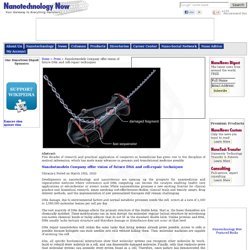
Ukraine | Posted on March 15th, 2010 Developments in nanotechnology and nanorobotics are opening up the prospects for nanomedicine and regenerative medicine where informatics and DNA computing can become the catalysts enabling health care applications at sub-molecular or atomic scales. While nanomedicine promises a new exciting frontier for clinical practice and biomedical research, issues involving cost-effectiveness studies, clinical trials and toxicity assays, drug delivery methods, and the implementation of new personalized therapies still remain challenging. DNA repair nanorobotics will utilize the same tasks that living systems already prove possible.
Epigenetics.